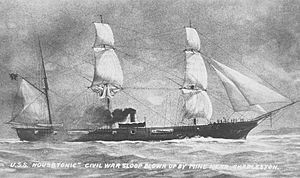USS Housatonic (1861) facts for kids
 |
|
Quick facts for kids History |
|
|---|---|
| Name | USS Housatonic |
| Namesake | The Housatonic River |
| Builder | Boston Navy Yard, Charlestown, Massachusetts |
| Launched | 20 November 1861 |
| Sponsored by | Miss Jane Coffin Colby and Miss Susan Paters Hudson |
| Commissioned | 29 August 1862 |
| Fate | Sunk 17 February 1864 |
| General characteristics | |
| Type | Screw sloop |
| Displacement | 1,240 long tons (1,260 t) |
| Length | 205 ft (62 m) |
| Beam | 38 ft (12 m) |
| Draft | 8 ft 7 in (2.62 m) |
| Propulsion | Sail and steam |
| Speed | 9 knots (17 km/h; 10 mph) |
| Complement | 160 officers and enlisted |
| Armament |
|
The USS Housatonic was a special kind of warship called a screw sloop. It was part of the United States Navy and was named after the Housatonic River in New England.
The Housatonic was built at the Boston Navy Yard in Charlestown, Massachusetts. It was launched on November 20, 1861. Two young women, Miss Jane Coffin Colby and Miss Susan Paters Hudson, helped launch the ship. It officially joined the Navy on August 29, 1862, with Commander William Rogers Taylor in charge. The Housatonic was one of four similar ships, along with the USS Adirondack, USS Ossipee, and USS Juniata. The Housatonic is famous for being the first ship ever sunk in battle by a submarine. This happened when it was attacked by the Confederate submarine H.L. Hunley in Charleston Harbor, South Carolina.
Contents
Service During the Civil War
Joining the Blockade
The Housatonic left Boston on September 11, 1862. It arrived in Charleston, South Carolina, on September 19. Its job was to join the South Atlantic Blockading Squadron. This squadron was trying to stop ships from getting in or out of Confederate ports. The Housatonic took its position outside the harbor entrance.
Capturing the Princess Royal
On January 29, 1863, the Housatonic helped capture a ship called the Princess Royal. This ship was an iron steamer trying to sneak into Charleston from England. It was carrying important supplies like engines for Confederate ironclad ships, weapons, and ammunition. Other Union ships, including the USS Augusta, USS G. W. Blunt, and USS America, also helped. The Princess Royal was forced ashore, and the Union crews boarded and refloated it. This cargo was very valuable to the South.
Confederate Attack on the Blockade
Two days after the Princess Royal was captured, two Confederate ironclad ships, the CSS Chicora and CSS Palmetto State, attacked the Union blockade fleet. This happened in the early morning fog. They rammed the Mercedita, causing it to surrender. They also badly damaged the Keystone State. Other Union ships like the Quaker City and Augusta were also hit. The Confederate ships then went back to safety under the protection of their shore batteries. The Housatonic fired at them as they left.
Capturing the Georgiana
On March 19, 1863, the Housatonic and the Wissahickon chased another blockade runner. This ship was the 407-ton iron-hulled steamer SS Georgiana. It was forced ashore on Long Island, South Carolina. The Georgiana was carrying a huge amount of supplies, including weapons, medicine, and other goods. Its cargo was worth over $1,000,000 at the time. This was a big loss for the Confederacy. The wreck of the Georgiana was later found by an underwater archaeologist named Lee Spence in 1965.
More Captures and Attacks
The Housatonic continued its work. On April 19, it captured a small ship called the Neptune. This ship was trying to leave Charleston with cotton and turpentine. The Housatonic also helped capture the steamer Seesh on May 15. The ship's smaller boats, which had howitzers, joined in the First Battle of Fort Wagner on July 10. This battle started a long period of attacks on the Confederate defenses around Charleston. In the following months, the crew of the Housatonic often used their boats to shell the shore. They also patrolled close to land to gather information and helped land troops for raids.
Sunk by a Submarine
Just before 9 PM on February 17, 1864, the Housatonic was on duty outside Charleston Harbor. Commander Charles Pickering was in command. A sailor named Robert F. Flemming, Jr. was the first to see something in the water about 100 yards away. He said it looked like "a plank moving in the water." Even though the crew quickly tried to move the ship and called everyone to their battle stations, it was too late.
Within two minutes of the sighting, the Confederate submarine H. L. Hunley attacked. It rammed its spar torpedo into the Housatonic's right side, near the back of the ship. This was the first time in history that a warship was successfully sunk by a submarine. The Housatonic began to sink very quickly. The crew managed to lower two boats, and many men climbed into the ship's rigging, which stayed above water. Two officers and three sailors on the Housatonic died.
The Confederate submarine H.L. Hunley got away, but it was lost with all its crew shortly after the attack. Later research suggests the submarine might have been very close to the explosion. This could have damaged the submarine itself. In 2017, scientists at Duke University showed that the blast's pressure wave likely killed the Hunley's crew instantly by damaging their lungs and brains.
The wreck of the Housatonic was mostly taken apart for scrap metal between the 1870s and 1890s. Its exact location was eventually forgotten. Today, the anchor of the Housatonic can be seen at the office of Wild Dunes on the Isle of Palms.


